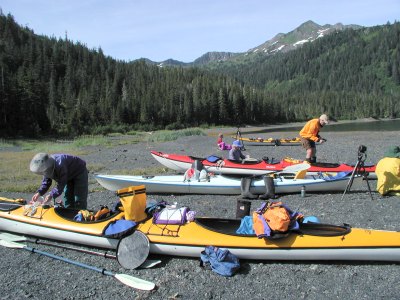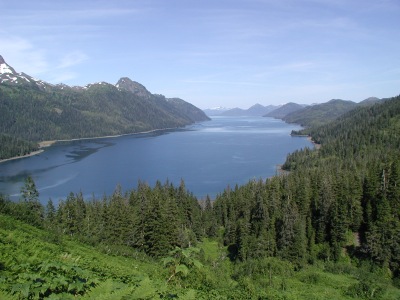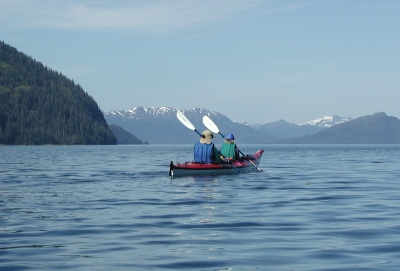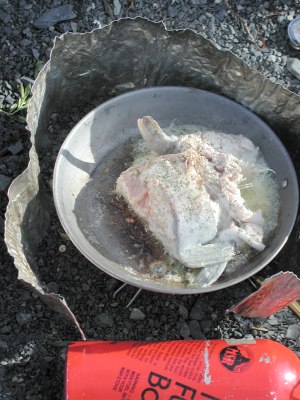Glacial Thunder: Sea Kayaking
in Prince William Sound 2001
Whale Bay and the "nature walk"
Sunday, August 12 By the time I had to get up to pee, it was already starting to get light, but it was nice to see an absence of a major cloud deck. At least we could get off to a good start on this trip. The lovely weather seemed to be incongruous with the distant "thunder" we had heard all night. Around breakfast, we decided that the continuous (every 5 - 10 minutes or so) rumbles had to be glaciers calving. If they made this much noise at this distance, it was hard to imagine what it would be like to be camped across from a large glacier. Our planned schedule would permit us to find out soon. Today was our so-called "layover" day. On backpacking trips, this usually means that most of the folks spend the day doing some local hikes out of camp. For us, it meant getting into our boats, and heading on down to the base of Whale Bay, about 4.5 miles away. THEN we would take a dayhike. For our morning excitement, we had a stove fire: Apparently, during the night, the gasket on Sue and Andy's Whisperlight had loosened up, and Sue did not check it before lighting up the stove. With the heat and consequent pressure increase, the fuel started oozing out of the stove while she went off to retrieve a food bag. The increase in pressure from the increased flames started pushing more and fuel out, and by the time that Susie looked over at it, it was a regular conflagration. I ran back to it, could see what was happening, and managed to drain all our water bags, trying to get the fire out. The fire did eventually give up, but by this time, the fire had melted a good part of the pump in the fuel bottle. Not a pretty sight, but thankfully, with 3 other stoves on the trip, it amounted to a minor inconvenience, rather than a real calamity.
 Even with the additional excitement, we all seemed to be ready to go by about 9:30 am. Susie and I were the last ones in our boat, and thus about 10 - 15 minutes behind everyone. This was our first time in a fiberglass kayak, and it is a little different than the plastic kayaks we had been renting. Most importantly, the shelf around which you hook your spray skirt is much more angular, which means it is easier to put the spray skirt on, and much more difficult to pull it off. Susie and I had not spent much time doing fine tuning adjustments before we pulled out of camp, so we were not as comfortable in the boat as we might otherwise had been. Despite the fact that our friends seemed to have decided, since the bay was like glass, to go on ahead and not wait for us to catch up, we were making what I THOUGHT was good progress down the bay. However, I, in control of the steering, tended to want to take the most efficient line, which took us out away from shore, which made it more difficult to for Susie to gauge our progress. It was frustrating for her to see our friends so far away, and seeming to pull away further. From a safety perspective, it is never good to have a single boat a half mile from the others, but I did have to admit with the near perfect weather conditions, and the impressive stability of the Tango, even with no gear in it, I felt very little apprehension about our situation.
Even with the additional excitement, we all seemed to be ready to go by about 9:30 am. Susie and I were the last ones in our boat, and thus about 10 - 15 minutes behind everyone. This was our first time in a fiberglass kayak, and it is a little different than the plastic kayaks we had been renting. Most importantly, the shelf around which you hook your spray skirt is much more angular, which means it is easier to put the spray skirt on, and much more difficult to pull it off. Susie and I had not spent much time doing fine tuning adjustments before we pulled out of camp, so we were not as comfortable in the boat as we might otherwise had been. Despite the fact that our friends seemed to have decided, since the bay was like glass, to go on ahead and not wait for us to catch up, we were making what I THOUGHT was good progress down the bay. However, I, in control of the steering, tended to want to take the most efficient line, which took us out away from shore, which made it more difficult to for Susie to gauge our progress. It was frustrating for her to see our friends so far away, and seeming to pull away further. From a safety perspective, it is never good to have a single boat a half mile from the others, but I did have to admit with the near perfect weather conditions, and the impressive stability of the Tango, even with no gear in it, I felt very little apprehension about our situation.
One of the challenging things for me is steering the kayak using the rudders. To Susie, this is uncomprehensible: you want to go right, you push on the right rudder, you want to go left, you push left, and you augment your ruddering the appropriate paddle strokes. Like, how much more simple does it need to be??!! However, while I have been canoeing off and on for 25 years, it is not the same, and it is the EXACT OPPOSITE of downhill skiing. When you ski, and you want to go right, you transfer more weight to the left ski, and vice versa. (Of course, the reason for this is the way the cables move the rudder, and the fact that the rudder is at the rear of the kayak: pushing on the right rudder peddle forces the stern to the left, which makes the bow go right.) Anyway, Susie and I had a good natured running argument about this going most of the week: when we would get into lots of icebergs, she, who had a much better view of what obstructions were in our most immediate path, would yell "Right!" Instinctively, I would push on the left peddle, which would push us left, and she would say again "Right, right!! No, the OTHER right!!!" (It should be noted here that despite my apparent ineptitude with steering, we had no significant boat/ ice encounters the entire week. Just wanted to clear that up. It should also be noted here that Susie, who had been downhill skiing for twice as long as I have, has never had any problems steering her kayaks: you want to go right, you push right. Must be a left brain, right brain thing.)
 About 70 minutes down the bay, I noticed some little bumps in the water, about 100 meters from us. I thought they were sea otters, and suggested we abandon the "most-efficient-line" approach and have some fun. It turns out that there were about a half dozen of these critters, laying on their backs and enjoying the sunshine (I guess anyway: who knows what goes on in the mind of a sea otter). As we got within about 30 yds or so, they became quite interested in us, but also quite wary. One by one, they would go from a reclining position to an upright one. They would poke their heads out of the water, seeming to get a better look at us, and then make a dive, moving way out to the right of us. Then we noticed another group of 3 or 4 off to our left, and went down to have them take a look at us. They repeated the behavior of the first group: relax, inspect, and dive. It was neat to watch them, but I wish we had been able to get closer. I knew the photos of these delightful mammals would be pretty marginal.
About 70 minutes down the bay, I noticed some little bumps in the water, about 100 meters from us. I thought they were sea otters, and suggested we abandon the "most-efficient-line" approach and have some fun. It turns out that there were about a half dozen of these critters, laying on their backs and enjoying the sunshine (I guess anyway: who knows what goes on in the mind of a sea otter). As we got within about 30 yds or so, they became quite interested in us, but also quite wary. One by one, they would go from a reclining position to an upright one. They would poke their heads out of the water, seeming to get a better look at us, and then make a dive, moving way out to the right of us. Then we noticed another group of 3 or 4 off to our left, and went down to have them take a look at us. They repeated the behavior of the first group: relax, inspect, and dive. It was neat to watch them, but I wish we had been able to get closer. I knew the photos of these delightful mammals would be pretty marginal.
We turned around, and headed for the beach at the most southerly end of Whale Bay, and landed after a run, including the otter diversion, of about 90 minutes. Andy quickly announced that we were 4.3 miles straight line distance from camp, which means we had paddled about 4.5 miles, or at 3 mph, including sightseeing and rest breaks. I always figure if you can make 3 miles per hour, you are doing fine, and this seemed to allay some of Susie's fears that we somehow were not up to the task of moving these big kayaks at an acceptable pace. Since the tide would be low around 1 pm, we did not feel like we had to haul the kayaks a hundred yards up on the beach. And besides, there was not a huge beach anyway. By the time we had secured our kayak, Tim was getting out his fishing rod, and was looking for salmon. I walked over to see where he was fishing, right at the mouth of a small creek, and the water was just boiling with salmon. I knew that this was the way it was when these fish spawn, but I had never seen this in real life. It is an incredible sight. The salmon were so thick that it was nearly impossible to keep from snagging a dorsal fin when you threw in a lure. Pretty amazing. As Dave and Tim moved out of the prime fishing spot, a black bear came down and made a couple of seemingly half hearted attempt to catch some salmon with his paws, but was unsuccessful. Tim and Dave resolved to surrender that particular fishing hole to the indigenous fauna, and work on the salmon still in the bay, heading for the creek.
Susie and I and Sue and Andy had decided that after lunch, we would hike up to the 600+ foot saddle at the SE corner of the bottom of the bay, and look down on Bainbridge Passage, which is on the Alaskan Marine Highway. It is a pretty narrow passage, but it is certainly deep enough for ocean going vessels. And we thought that the hike would get us a little better feel of the vegetation around there: boy did it ever. Dave was content to spend his time photographing along the beach. He had brought his new Hasselblad medium format camera on this trip, in addition to his Nikon F-80 35 mm, and thought he could best spend his time on the beach. Diane wanted to get some fishing in as well, and with Tim already being successful with one fish caught, we knew that there would be salmon in our bellies for dinner. Note to all readers: Beware when the trip organizer elects NOT to go on the day hike she has planned for you!! Diane indicated that the route they had taken a few years ago started on the right side of the drainage, and stayed pretty much in open country all the way to the saddle. So even though it looked a bit easier on the left side, we opted to follow her suggestion. The four of us took off right behind our lunch spot, and then began working our way around to the left, but staying on the right side of the creek coming down from the saddle. The creek was losing a lot of elevation quickly, so it was not hard to have the motivation to stay out of the creek proper. As we worked our way upward, the vegetation became increasingly dense: huge ferns, Cow Parsnip and Devil's Club. If you have never had the opportunity to ascend a steep slope heavily covered in Devil's Club, well, you are in for a real treat. We pushed through the vegetation, trying to gain elevation, and cursing the fact that we could neither see our feet nor the sky much of the time, and having no place on which to grab, since the spines all over the Devil's Club made it such an unappetizing choice. I have never heard so much cursing out of Andy's mouth. Susie remained remarkable soft spoken, maybe because she had left her nylon wind shirt on, and while she was stewing in that, at least her forearms were not getting torn up.
We must have pushed uphill for over an hour, measuring our progress in yards, not miles. I have done a fair amount of cross country hiking in the Smokies, where the vegetation can get pretty thick. I have NEVER tried anything this rough. I could not believe that Diane and Tim had experienced so little difficulty. Ultimately, we decided that this was about as much fun as we could tolerate, since all we were accomplishing was tearing up ourselves and the vegetation, and we had not gained half the elevation that we needed to. I turned around, snapped a photo with the digital camera, and joined the others in the descent. We had been whupped, but at least, the end of the misery was in sight. It still took us over 30 minutes to get back down. We reported our lack of success to Diane, who had a big smile on her face, since she had added a salmon to our larder. We talked about the hike a bit, and then she recalled that they had done the trip in early June, and remembered having to cross a lot of snow on the way to the saddle.  Then it all became clear: Alaska's growing season is notoriously short but powerful, and maybe in the couple of months between Early June and mid-August, these Devil's Clubs and Cow Parsnip grow like crazy. Alternatively, they were buried underneath the snow when T&D did the route, which is a much better way to deal with this hateful stuff. All of us on what became to be referred to as our "Nature Walk" had blisters and red streaks all over our wrists and forearms. Turns out that in addition to imbedded spines from the Devil's Club, the Cow Parsnip exudes a material that causes contact dermatitis. Wonderful!!
Then it all became clear: Alaska's growing season is notoriously short but powerful, and maybe in the couple of months between Early June and mid-August, these Devil's Clubs and Cow Parsnip grow like crazy. Alternatively, they were buried underneath the snow when T&D did the route, which is a much better way to deal with this hateful stuff. All of us on what became to be referred to as our "Nature Walk" had blisters and red streaks all over our wrists and forearms. Turns out that in addition to imbedded spines from the Devil's Club, the Cow Parsnip exudes a material that causes contact dermatitis. Wonderful!!
After we cleaned up, it was time to start thinking about heading back to camp. We had enough salmon to satiate our hunger, and it was time to start thinking about preparing to move camp. Susie and I were first in the water, but soon everyone else seemed to pass us, and it was clear that on this trip, we would be dragging up the rear (or so we thought). The kayak was a bit tougher to steer than a smaller boat, and it was also clear that we would have to do some major adjustments in the cockpits: My rudder peddles were still too close to me, and Susie's back support was pushing up her PFD (personal flotation device) nearly up to her head. When we got back into camp, we took at look at things, and found that one of the supports for Susie's back rest had come out of it's holder in the kayak, and the seat back was way too far forward, so it seemed for her that the best thing to do was to loosen the entire back support, and let her PFD do the supporting.  Also, her butt was sore from the lack of any kind of padding on the seat. I moved the peddles out a bit further, and all these adjustments would dramatically improve both our comfort and paddling efficiency. We also had to work on the leaders' boat. Tim had broken a rudder cable on the way down the bay, so we had tried to fix it with some nylon cord. Fixing things by committee is not always the best way to handle things, but in this case, it worked very well. We tied a knot in the end of the cable, made a perfectly sized loop out of nylon cord, and attached it to the rudder. It held the rest of the week.
Also, her butt was sore from the lack of any kind of padding on the seat. I moved the peddles out a bit further, and all these adjustments would dramatically improve both our comfort and paddling efficiency. We also had to work on the leaders' boat. Tim had broken a rudder cable on the way down the bay, so we had tried to fix it with some nylon cord. Fixing things by committee is not always the best way to handle things, but in this case, it worked very well. We tied a knot in the end of the cable, made a perfectly sized loop out of nylon cord, and attached it to the rudder. It held the rest of the week.
Of course, prior to dinner, it was time to take a bath, and I had my eye on some sun-warmed pools up on a flat area just south of camp. Susie opted for a sponge bath with some bagged water inside the tent, away from the bugs. In my exploring for a warm pool, I realized I was crossing a boggy area that was covered with sun dew. These plants are insectivorous plants that grow in high elevation, boggy area in the Southern Appalachians, and points further north. They are exquisite plants when you regard them close up. I had never encountered several acres at a single time. The prospect of dinner enhanced with salmon steaks, lubricated with wine, and bodies washed from the dirt and sweat, if not the scars, from our Nature Walk, seemed to improve everyone's mood. It was warm, like in the high 60's, this evening, and in the sun, with the bugs in your face all the time, one had to be careful not to work up a sweat. Susie and I had lemon pepper penne pasta, with dried prosciutto and smoked turkey, with salmon steaks poached in dill weed and lemon butter for an appetizer, and life was feeling pretty good. After dinner, I did some brownies on our Bakepacker, but was not paying attention to the steam generation, and did not catch that the water in the bottom of the pot had disappeared. It melted a lot of the plastic bag, singed the pot bottom, but the brownies were good, and everyone enjoyed a bite.
© Roger A. Jenkins & Suzanne A. McDonald, 2001
